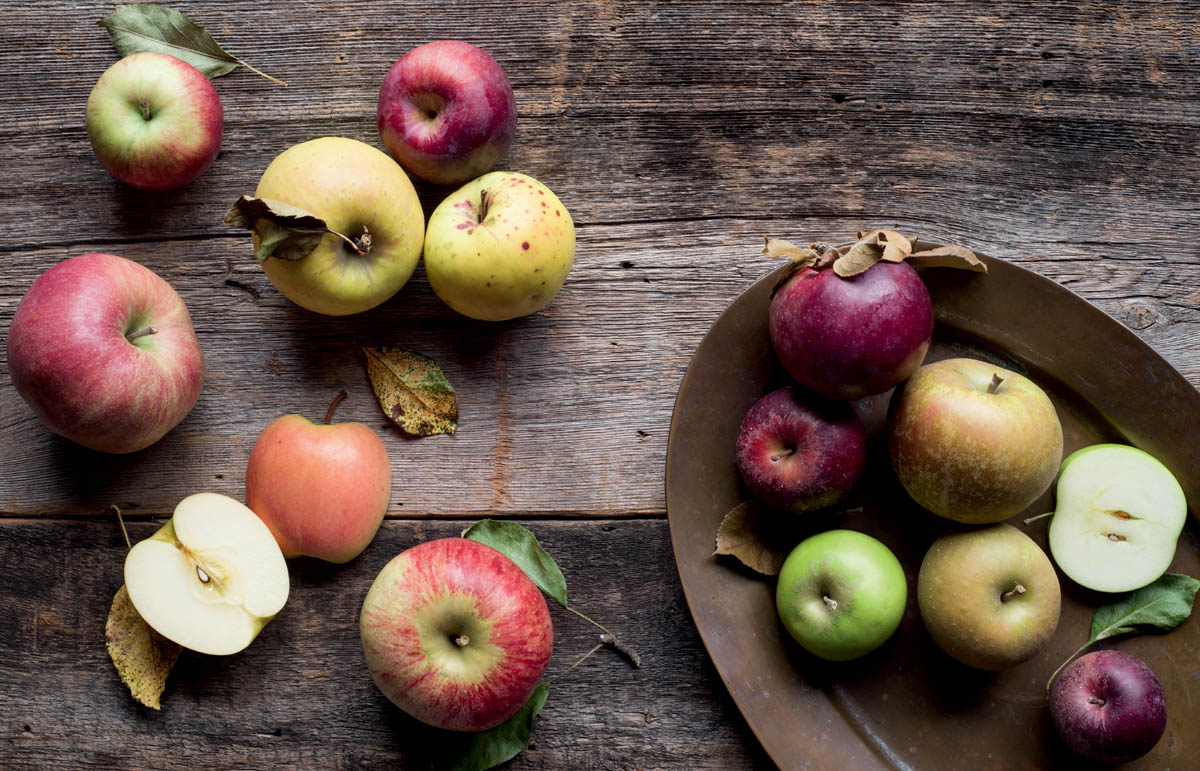
Descriptions of the general characteristics of apples should be taken as just that — general. Like that of wines, the quality of apples depends on many factors — latitude, terrain, weather, and the care with which they are grown, among others. Apples of the same variety vary not only from year to year but also from day to day as they mature.

I’ve had apples from the same bag, in fact, that varied widely in appearance and taste. Maybe they were the same shape, but the colors were remarkably different, depending on the degree of ripeness.
The background, or undercast, color of an apple changes from dark green to light green to yellow as it ripens, and the surface turns a bright red or a deeper yellow. In some apples, the surface color completely obscures the background color. Take, for example, one of my favorite apples, the Empire. Sometimes it is all bright red, other times bright red on a yellow background. A knockout of juicy spiciness when fully mature, the Empire is flat and uninteresting when eaten before its prime.
Some apples at first look are only a solid green, yellow, or red, but, on closer inspection, it can often be seen that they are faintly streaked, marbled, or dotted with a yellow or pink blush. Get to know the apples — from everyday varieties to heirlooms to new hybrids — in the following pages.
The following descriptions cover those apple varieties that are the most popular with the orchardists, are good keepers, and are available for several months in a number of U.S. states and Canadian provinces.
Braeburn. Discovered as a seedling in New Zealand in 1952, it is believed to be an offspring of the Lady Hamilton. A yellow-skinned apple blushed with red stripes, Braeburn has pale cream flesh that is crisp, juicy, and sweetly tart. A favorite apple for fresh desserts, it is also good for baking and making into a deliciously sweet applesauce.
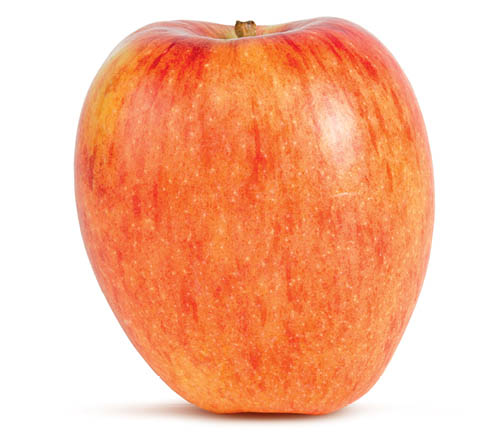
Braeburn
Cameo. Discovered in the 1980s as a chance seedling in a Golden and Red Delicious orchard in the Wenatchee River Valley, Washington, it was released on the market in 1987. It is a large apple with yellow- and red-striped or spotted skin. The flavorful flesh is crisp, juicy, and sweet-tart, making it a good keeper and all-purpose apple. The dense, cream-colored flesh also resists browning, so it is an ideal contender for salads and fruit plates.
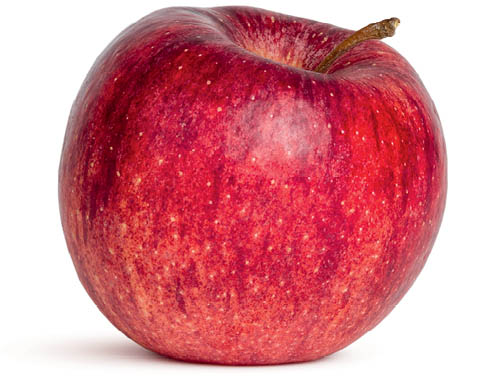
Cameo
Cortland. This apple, a cross between a Ben Davis and a McIntosh, was developed by the New York State Agricultural Experiment Station in Geneva, New York. It entered the commercial market in 1915. Cortlands are grown mainly in the Northeast, the northern Great Lakes states, and eastern Canada. A medium-to-large red-and-green-striped apple, it is crisp, juicy, and sweetly tart. Because its white flesh resists browning, Cortland is favored for salads and fruit cups. It is also a good all-purpose apple.
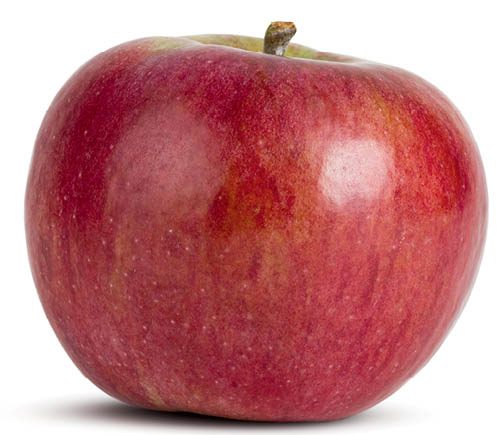
Cortland
Fortune. Developed by the Cornell University New York State Agricultural Experiment Station in 1996 as a cross between Empire and Red Spy, it resembles both with its tender red skin and spicy sweet-tart flavor. A larger apple with crisp cream-colored flesh, the Fortune has all the qualities of a great all-purpose apple for baking, cooking, salads, and eating out of hand.
Fuji. This flavorful, aromatic apple is the number-one seller in Japan, where it was developed in 1958 by crossing the Ralls Genet and Red Delicious. A pretty apple with yellowish-green skin blushed with orange-red stripes, it has dense, crisp, and sweetly tart light yellow flesh. Fuji retains its flavor even when stored at room temperature and develops a better flavor when held in long-term storage. An excellent apple for eating out of hand, adding to salads, and making into applesauce.
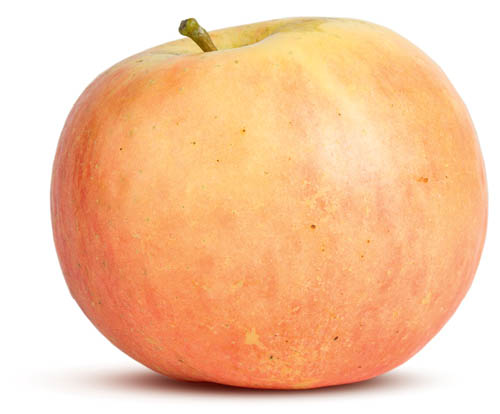
Fuji
Gala. Developed in 1934 in New Zealand by J. H. Kidd of Greytown, Wairarapa, Gala (sometimes called Royal Gala) is a cross of Kidd’s Orange Red and Golden Delicious. The thin, red-orange skin — actually red striping over gold — encases aromatic, semisweet, yellowish-white flesh. Crisp and juicy, it is a good apple for eating out of hand, using in salads, and pairing with soft, mild cheeses.
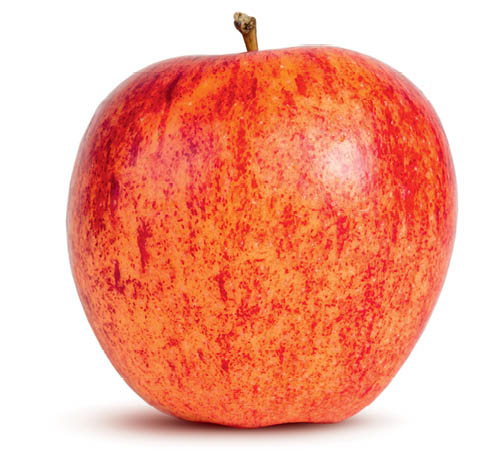
Gala
Ginger Gold. Ginger Gold was discovered as a seedling in an orchard in Virginia after Hurricane Camille devastated the area in 1969. It is believed to be the offspring of Albemarle Pippin. It is a large apple with greenish-gold skin, which is sometimes tinged with a slight blush when fully mature. The crisp, juicy flesh is pure white and resists turning brown for hours after it has been peeled and cut. This combination makes Ginger Gold a good choice for salads, hors d’oeuvre trays, and garnishes. When the apple is first picked, its flavor is tart with a sweet aftertaste, but as it matures under refrigeration, its flesh becomes mellow and honey sweet. Ginger Gold is best eaten within two months of harvest.
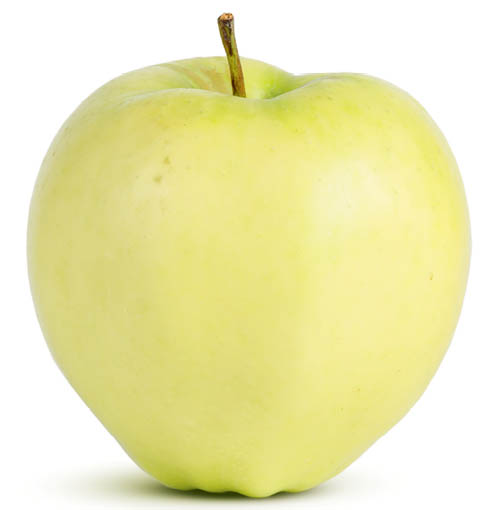
Ginger Gold
Golden Delicious. Grown in most regions across the country, Golden Delicious is the second-most grown after Red Delicious, to which it is not at all related. The Golden Delicious (or Yellow Delicious, as it is sometimes called) was discovered in West Virginia in 1914, when it was called Mullin’s Yellow Seedling. Stark Bro’s Nursery, in Louisiana, Missouri, which specializes in acquiring the rights to new apple varieties, later acquired the Golden Delicious. Sometimes, the nursery has found new varieties through fruit competitions it sponsored. This is a medium-to-large pale yellow or yellow-green apple that is mild and sweet. Although it is crisp when harvested in September and October, its pale flesh often becomes dry and soft. Its skin shrivels when not refrigerated. Particularly desirable for snacks, fresh desserts, and salads, the Golden Delicious is a good all-purpose apple.
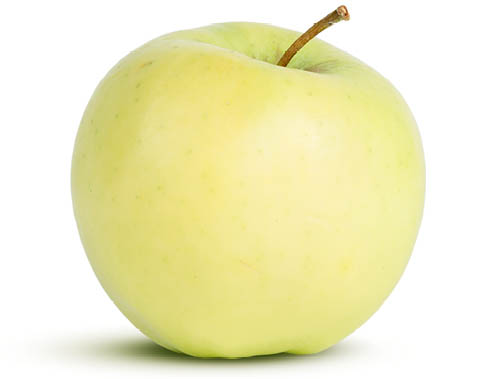
Golden Delicious
Granny Smith. Although one of the most popular varieties sold in the United States, it is imported here year-round from the Southern Hemisphere. Granny Smith originated in Sydney, Australia, about 100 years ago and is now grown in several states. It is a medium pale green apple that, depending on maturity, is mildly to very tart. It is crisp and firm, and even though it doesn’t have great flavor, its rather hard flesh makes it a good all-purpose apple. The U.S. crop is available from October through June.
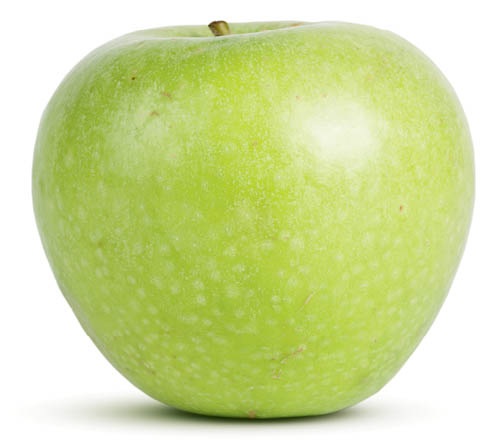
Granny Smith
Honeycrisp. A cross between Macoun and Honeygold, this outstanding keeper was developed at the University of Minnesota in 1991. This is a large apple with red-and-yellow-striped tender skin encasing superbly crisp, sweet-tart, honeyed flesh dripping with juice. This apple has nudged Red Delicious lower on the rung, and for many consumers Honeycrisp is their number-one choice for snacking and salads. It is also excellent for sauce and as an all-purpose cooking apple.
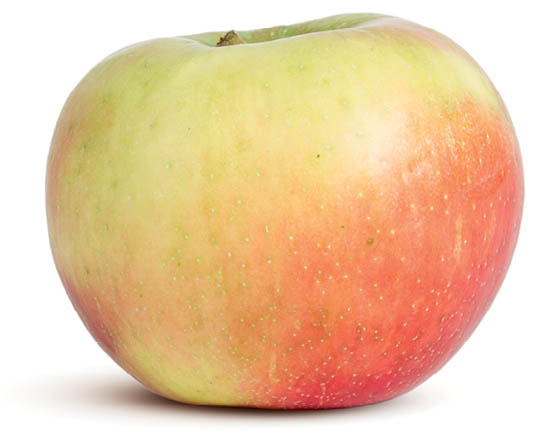
Honeycrisp
Idared. This apple was scientifically developed in 1942 at the University of Idaho Agricultural Experiment Station. It is a cross between a Jonathan and a Wagener. Although it is grown in greatest volume in the Northeast and Upper Midwest, its production is increasing by popular demand throughout the country. It is medium to large and bright red, and it has creamy white flesh that is very firm, crisp, and juicy. All-purpose apples, the sweetly tart, deliciously spicy Idareds are especially good for snacks and desserts, and their firm quality makes them particularly desirable for baking. The flavor improves after several months in controlled-atmosphere storage.
Jazz. The trade name for Scifresh, a variety developed in New Zealand, this Braeburn–Royal Gala cross was first planted in Washington State by the McDougall family in 2004 and is now ranked as one of the top 10 apples. Tangy-sweet and crisp, this red-splashed-with-yellow apple retains its crunch for a long time, making it an exceptional keeper. It is great apple for the lunch box and salads, and its flavor and texture also hold up in cooked and baked dishes.
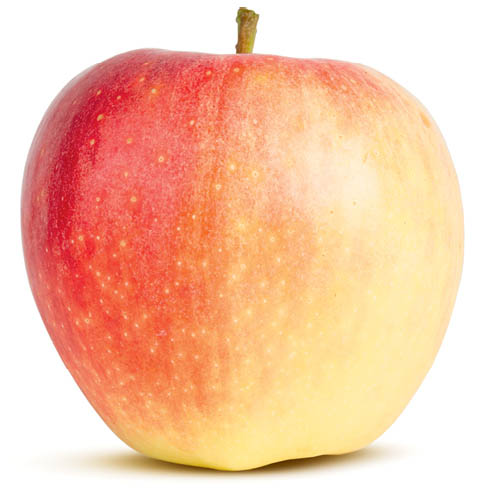
Jazz
Jerseymac. This is a medium-to-large red apple with a green undercast. Its tough skin encases flesh that is tangy, crunchy, and juicy. Although it makes a good all-purpose apple, it does not keep well.
Jonagold. The Cornell University New York State Agricultural Experiment Station developed the Jonagold by crossing Jonathan and Golden Delicious. It was introduced to American consumers in 1968. A large, slightly elliptical apple with red skin or yellow skin blushed with faint orange-red stripes, it has flesh that is supercrisp, juicy, and an even balance of sweet and tart. Jonagold is an excellent all-purpose apple, one of the best for eating out of hand.
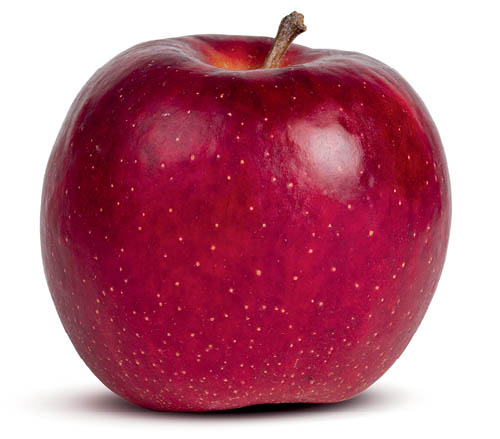
Jonagold
Jonamac. A small-to-medium, red-on-green apple that is firm, mildly tart, and juicy, it can be considered an all-purpose apple. However, it is not a good keeper.
Macoun. A cross between a McIntosh and a Jersey Black, this is a medium red apple that sometimes has an unattractive gray bloom. However, its snow-white flesh is supercrisp and juicy, and its honey sweetness makes up for its mild flavor.
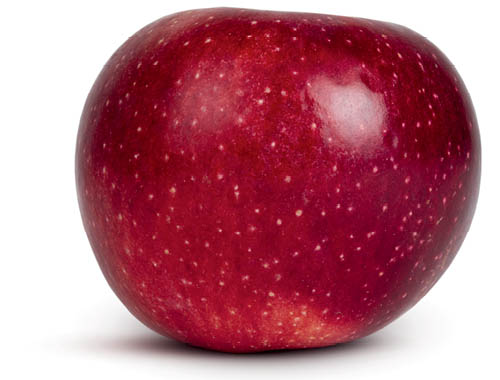
Macoun
McIntosh. John McIntosh discovered this apple in Ontario, Canada, in 1830. Ranking third in volume in the United States, it is grown throughout the Northeast, the northern Great Lakes states, eastern Canada, and British Columbia. It is a medium red-on-green apple, with sweet flesh that is crisp, juicy, and slightly perfumed. Macs are excellent to eat fresh in autumn; later, they are best used for sauce. McIntosh apples collapse when baked whole or in pies.

McIntosh
Melrose. In 1970, the Ohio State Horticultural Society named Melrose the official state apple. It has a somewhat flat shape, and the skin is a dull red on yellow. However, it makes up for its drab appearance with firm, crisp flesh that is sweet, juicy, and flavorful. Melrose is an excellent all-purpose apple.
Mutsu/Crispin. This descendant of Golden Delicious was introduced into the United States by the Japanese in 1948. Although grown mostly in the Northeast, Mutsu is gaining wider popularity. The very large yellow-green fruit is not unlike the Golden Delicious; however, the flesh is much juicier and coarser, and its skin suffers less from storage. It is an excellent all-purpose apple.

Mutsu/Crispin
Patricia. A star, this is so limited in production that it sells out very quickly during the second week of September. One of the very best eaters, but not a good keeper, it is a small, light green and yellow apple splashed with pink. It is crisp, crunchy, juicy, and sweet and tastes of “apple.”
Paula Red. This variety was discovered in 1960 in Sparta, Michigan, and introduced commercially in 1967. It is grown mostly in the Northeast and northern Midwest states. A medium, early-September apple, it is usually red, though sometimes shaded with yellow-green. The flesh is crisp, juicy, and sweetly tart. Although Paula Reds are fair all-purpose apples, they are not good keepers and should be used within six weeks or so of harvest.
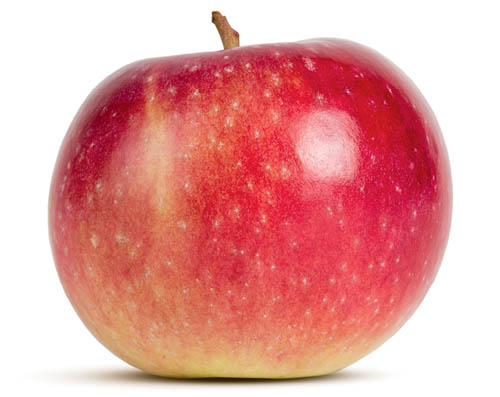
Paula Red
Pink Lady (aka Cripps Pink). This intensely flavored sweet-tart apple with its bright pink skin flecked with yellow-green was developed in Australia in the 1980s as a hybrid cross of Golden Delicious and Lady Williams. An all-purpose apple when fresh, its flesh turns amazingly sweet during long-term storage and is then best for salads, fruit plates, snacking, and in sauce.
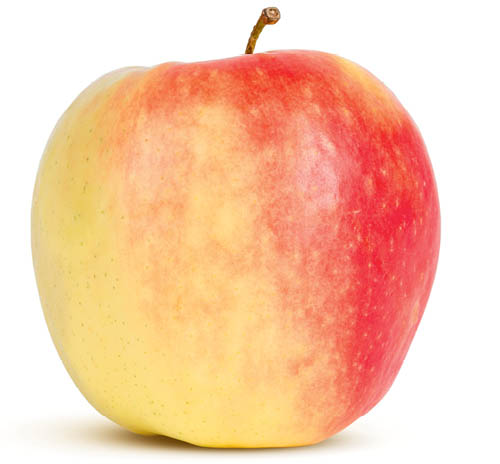
Pink Lady
Raritan. This red-on-green apple has a great “apple” flavor and is one of my all-time favorites. It has wondrously crunchy, juice-spurting flesh that is mildly tart-sweet. It is a great thirst quencher.
Red Delicious. The Red Delicious is grown throughout the United States and is still America’s most popularly grown apple. It was called Hawkeye when it was discovered in 1872 in Peru, Iowa, and was renamed Delicious in 1895 by the Stark Bro’s Nursery. (George Stark is said to have proclaimed, “It’s delicious,” when he took a bite of Jesse Hiatt’s Hawkeye during the judging of the Stark’s 1892 apple competition. The Stark Nurseries bought the rights for Hawkeye from Hiatt and first called it Stark Delicious.) This bright red apple is crisp and juicy when harvested in September and October. Although Red Delicious is considered a good keeper by the industry, its sweet and mild-tasting flesh is all too often a mealy, mushy disappointment. It is best used for snacks, salads, and fruit cups.
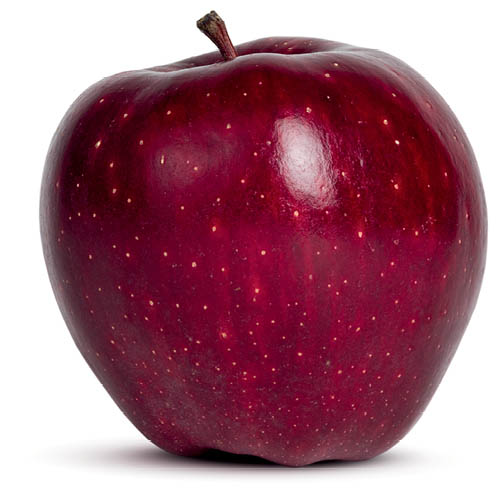
Red Delicious
Rome Beauty. This large deep red apple was found growing in Rome, Ohio, in 1816. The flesh is sweet, mildly tart, dry, and firm. Although mediocre for eating fresh, Rome Beauty is very good for baking because it retains its shape and flavor. For that reason it remains one of the most popular varieties grown throughout the United States.
Stayman. Stayman apples were discovered in Leavenworth, Kansas, in 1866 and originated from Winesap seeds. For that reason, they are sometimes incorrectly called Stayman Winesap. They’re grown in the Northeast, eastern Midwest, and South Atlantic states. Stayman is a medium deep red apple, often shaded with green (it sometimes fails to ripen in the Northeast). Its sweetly tart flesh is crisp and juicy and is delicious for eating fresh. It is also a good all-purpose apple.
Winesap. Thought to have originated in New Jersey in the late 1700s, Winesap is one of our oldest apples still in commercial production (Newtown Pippin is the other). Although it is grown in most apple-producing regions, its heaviest volume comes from the Northwest and the Mid-Atlantic states. The Winesap is of medium size, with a thick red skin and crisp, crunchy, juicy flesh. The flavor is sweetly tart with a winey aftertaste. It is an excellent all-purpose apple.
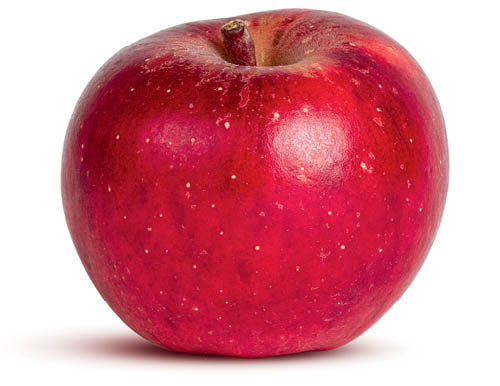
Winesap
York Imperial. When this apple was first discovered at York, Pennsylvania, around 1830, it was called Johnson’s Fine Winter Apple. It is grown in the Appalachian states of Pennsylvania, West Virginia, Virginia, Maryland, and Delaware, and its production volume is high enough to rank sixth in the United States. An apple of medium size with a lopsided shape, it has deep red skin with greenish-yellow streaking. York Imperial is a crisp, firm apple that is both sweet and tart, with a somewhat mild flavor, and it is in great demand for commercial processing into pie filling and sauce. It is a good all-purpose apple that mellows in cold storage.
Thousands of apple varieties evolved in the United States during the seventeenth, eighteenth, and nineteenth centuries when Colonial farmers decided to plant apple seeds instead of the young apple tree shoots, or scions, that were transported from England and the Continent. It was thus they found that the seed of an apple did not produce a tree of the same original variety. It was also during the eighteenth and nineteenth centuries that apple seeds were spread from coast to coast by the legendary Johnny Appleseed. Born John Chapman in 1774 in Massachusetts, he traveled the new territories for 40-odd years, selling seeds, cuttings, and plants.
The demise of certain apple strains was inevitable. With thousands of varieties to be eaten and sold, those that spoiled quickly were considered a bad risk. By the turn of the twentieth century, when transportation became more reliable and all manner of food was available from different areas of the country and various parts of the globe, the heavy reliance on homegrown and local food was drastically diminished. No longer was the home orchard the main source of fruit. Consequently, it was no longer practical to grow such a wide variety of apple trees. Only those that produced apples judged to be good keepers and the best for making pies, sauce, and cider were cultivated. Apples that could not stand up to shipping and long storage were discontinued, as were trees that did not bear their first crop for 10 years, and then only every other year thereafter. Also neglected were those apples with rough, brownish, or mottled skins, deemed to be aesthetically unacceptable to the American public.
Another important element contributed to the elimination of some apple varieties. In 1918, the ravages of a severe winter took their toll on thousands of apple trees in the East. In starting over, commercial orchard growers followed the recommendations of pomologists and planted an abundance of McIntosh, Red Delicious, Golden Delicious, and Rome Beauties. However, such old-time favorites as Wealthy, Tolman Sweet, Pound Sweet, Rhode Island Greening, and Baldwin can still be found in some of the smaller commercial orchards whose clientele is local rather than nationwide.
Indeed, I consider it a lucky day when I stumble upon an old-fashioned orchard, where the gardener prefers flavor to abundance. Such varieties can be a revelation — not only in taste but also in name and appearance.
Ashmead’s Kernel. This apple was grown around 1700 by Dr. Ashmead in Gloucester, England. Considered one of the finest dessert apples, it has a sugary sweetness that is deliciously tempered by a touch of acid in the juice. Adding to this wonderful flavor, the slightly green, yellow flesh is crisp and aromatic. Ashmeads, somewhat lopsided and conical in shape, have golden-bronze russet skin blushed with orange.
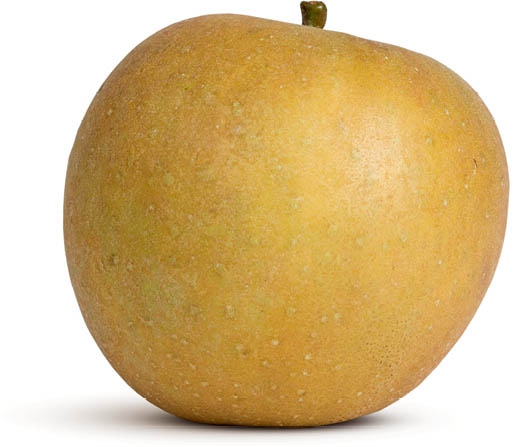
Ashmead’s Kernel
Baldwin. This apple originated in Wilmington, Massachusetts, around 1740. Grown mostly in New York State and New England, it is no longer popular with commercial growers because it takes about 10 years to bear fruit, and then does so only biennially. It is a large red apple, streaked with yellow. The flesh is firm, crisp, juicy, moderately tart, and aromatic. This is a good all-purpose apple.
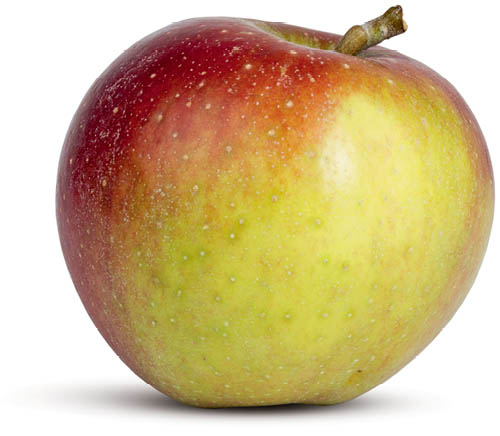
Baldwin
Black Gilliflower or Sheepnose. This apple, discovered in Connecticut in the late 1700s, has the shape of a sheep’s nose and deep purple-red skin. The flesh is firm, sweet, and fragrant. It is delicious for eating out of hand and can also be used for baking.
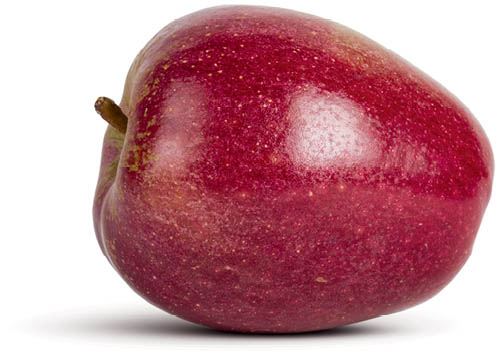
Black Gilliflower
Black Twig. Sometimes spelled Blacktwig, this apple is also known as Twitty’s Paragon. Discovered as a seedling around 1830 on the farm of Major Rankin Toole in Fayetteville, Tennessee, it was distributed by Twitty’s nursery. In the nineteenth and early twentieth centuries, Black Twig was a popular variety with orchardists in central Virginia. Considered a good keeper, this juicy and aromatic apple needs some storage time for its yellow flesh to develop the best flavor. The attractive skin is usually yellow striped and blushed with dark red.
Chenango Strawberry. This originated in New York State in the mid-1800s and is a pale yellow apple with pink stripes. The soft flesh has a distinctive strawberry fragrance.
Cox Orange Pippin. Pippin was a common term for a small apple when this one originated in England around 1830. It is wonderfully aromatic, with a rather rough, deep yellow skin that is splashed with orange and red. The flesh is crisp, tender, and fragrantly juicy, making it one of the best dessert apples. It also makes choice cider.
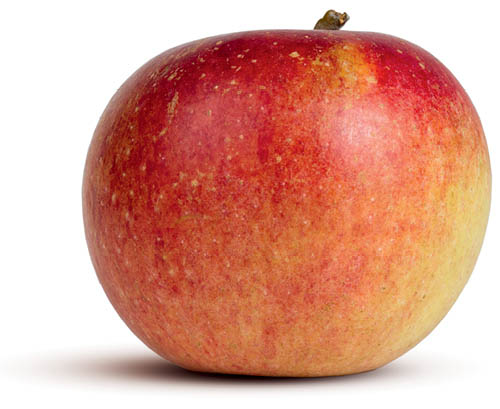
Cox Orange Pippin
Duchess of Oldenburg. First imported to England in 1815 from Russia, this apple was brought to the United States in 1835. Its tender, red-striped skin encases yellow-tinged flesh. Crisp, firm, and juicy, it is highly rated for pies and sauces but considered too tart for eating out of hand.
Fameuse or Snow. Originating in France, this has been grown in New York and Vermont since around 1700. It is small and firm, with bright red, sometimes purple, skin. Its snow-white, crisp flesh may be striped with red. Excellent for eating raw in desserts and salads, it does not hold its shape during cooking.
Jonathan. This was called a Rick apple when it was first introduced in 1826 at Woodstock, New York. Although it represents the fifth-largest apple crop in the United States, its production in the North is now limited. It is a medium red apple with an attractive yellow blush. The flesh is firm, crisp, juicy, and sweetly tart, with a spicy aftertaste. A great all-purpose apple that holds its shape well, Jonathan is in demand for baking whole and in pies.
Lady. This small apple originated in France during medieval times. With its red and green skin and firm, crisp, white flesh, it is very much in demand around the Christmas season for table decorations. It is delicious to eat fresh and makes good cider. It is not related to the much larger Pink Lady.
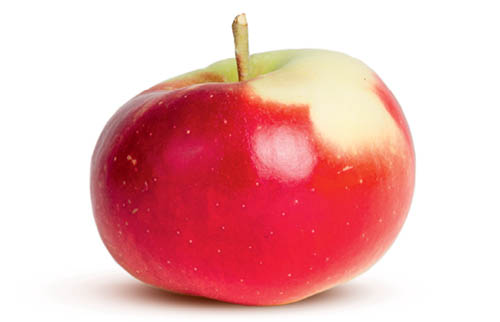
Lady
Newtown Pippin. Supposedly discovered in Newtown, New York, on Long Island, in 1758, this is one of the oldest varieties to be found in commercial production. It is now grown in several states and is a great favorite with the processing industry — its firm, crisp, juicy, and sweetly tart flesh makes it ideal for pie fillings and sauce.
Northern Spy. This apple originated at East Bloomfield, New York, around 1800. Today, it is grown mostly throughout the Northeast, the northern Midwest, and eastern Canada. This is a medium-to-large apple with a pale green to yellow undercast, heavily striped with red. Its mellow, creamy flesh is crisp, juicy, and richly aromatic — qualities that are prized by the commercial processing industry. It is an excellent all-purpose apple and freezes well. Because it is a biennial bearer, Northern Spy is declining in popularity with commercial orchardists.

Northern Spy
Porter. A large yellow apple splashed with red, it originated in Massachusetts around 1800. Its firm white flesh is crisp, tender, and flavorful. It is ideal for canning, cooking, and eating raw.
Pound Sweet or Pumpkin Sweet. This apple originated in Connecticut around 1850. It is very large, with green-on-yellow striped skin. The flesh is yellow and juicy, with an unusual and rather sweet flavor. It is good for baking.
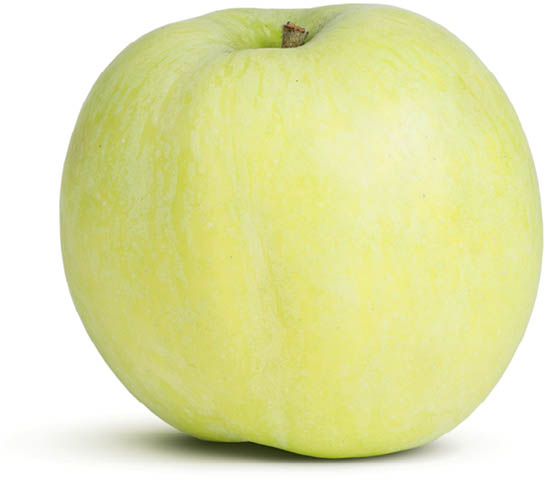
Pound Sweet
Red Astrachan. This apple reached the United States from Russia around 1835. Its pale yellow skin is splashed with bluish-red stripes, and the juicy white flesh is often tinged with red. An early-summer apple that ripens unevenly and does not keep well, the Red Astrachan is used for cooking before it is fully mature. However, when ripe, it is excellent for eating fresh in desserts and salads.
Rhode Island Greening. This variety originated around 1700 from a chance seedling found growing outside a Rhode Island tavern owned by a Mr. Green of Green’s End, Newport. The bright green skin surrounds flesh that is crisp, juicy, and tart. If allowed to ripen, it becomes mellow enough to be eaten out of hand. However, most orchardists pick it “green,” which makes it a perfect pie apple.
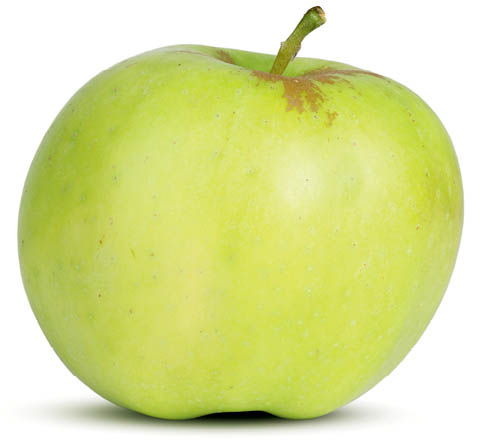
Rhode Island Greening
Roxbury Russet. A real American oldie that originated in Roxbury, Massachusetts, around 1635. Its gold skin is mottled with flecks of brown and red; the crisp yellow flesh is deliciously sweet. Excellent for eating fresh and making into cider, it also has a long storage life.

Roxbury Russet
Smokehouse. William Gibbons grew this apple near his smokehouse during the early nineteenth century in Lancaster County, Pennsylvania. Its yellowish-green skin is mottled with red and the creamy flesh is firm and juicy, making it a good candidate for fresh desserts and the salad bowl. It is not recommended for cooking.
Sops of Wine. With red-flecked white flesh that resembles bread dipped in wine, this apple has a pedigree that goes all the way back to medieval England.
Summer Rambo. One of the older varieties, it originated in France, where it was called the Rambour Franc, and was introduced into the United States in 1817. This large apple is greenish yellow with red stripes. The tender, juicy flesh makes it ideal for eating fresh and making into sauce.
Tolman Sweet. This apple is said to have originated in Dorchester, Massachusetts, around 1822. Its greenish-yellow skin is sometimes blushed with light pink. The white flesh is exceptionally sweet, and it is considered the best for making naturally sweet applesauce. It is also good for baking and eating fresh.
Tompkins King. Discovered in New Jersey around 1800, it is a large yellow apple splashed with broad red stripes. The skin is tender and the creamy flesh crisp, juicy, and moderately tart. Not a favorite for eating fresh, it is best used for cooking.
Twenty Ounce. It was first exhibited in Massachusetts around 1845 and is thought to have originated in Connecticut. This is a large green apple splashed with red stripes when ripe. Its firm, tart flesh is encased in tough skin. This combination makes it superb for cooking.
Wealthy. This thin-skinned, pale yellow apple, heavily shaded with red, was discovered in Minnesota around 1860. Its crisp, juicy white flesh is often streaked with red. It’s an excellent apple for eating fresh, for cooking, and for making cider.
Westfield Seek-No-Further. At one time considered the finest of dessert apples, this one originated in Westfield, Massachusetts, around 1796. The skin of this yellowish-green apple is splashed with red, and the pale yellow flesh is crisp, juicy, and flavorful.
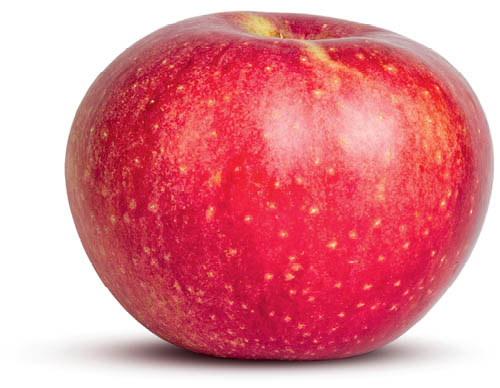
Westfield Seek-No-Further
Winter Banana. Over 100 years old, this variety originated in Indiana. It has pink-on-yellow cheeks and, not surprisingly, a flavor reminiscent of bananas.
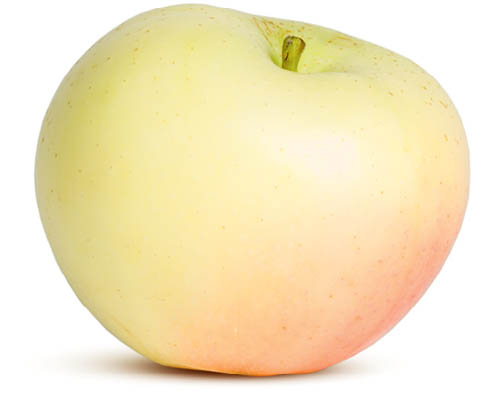
Winter Banana
Wolf River. Named after the Wolf River in Wisconsin, where it was found, this apple is thought to have originated in 1880. It is an oversized apple, and stories abound in which only one apple was necessary for a whole pie. Its skin is pale yellow, heavily streaked with red, and the light yellow flesh is firm, tender, and juicy. It’s excellent for eating fresh and cooking.
Excellent: Ashmead’s Kernel, Black Gilliflower, Braeburn, Cameo, Fameuse, Fortune, Fuji, Honeycrisp, Jazz, Jonagold, Jonathan, Lady, Macoun, Mutsu/Crispin, Patricia, Pink Lady, Porter, Raritan, Roxbury Russet, Summer Rambo, Wealthy, Winesap, Wolf River, York Imperial
Good: Baldwin, Black Twig, Chenango Strawberry, Cortland, Gala, Ginger Gold, Golden Delicious, Granny Smith, Idared, Jerseymac, Jonamac, McIntosh, Melrose, Newtown Pippin, Northern Spy, Paula Red, Red Delicious, Stayman, Tolman Sweet
Excellent: Ashmead’s Kernel, Braeburn, Cameo, Cortland, Fameuse, Fortune, Fuji, Ginger Gold, Golden Delicious, Honeycrisp, Jazz, Jonagold, Red Astrachan, Smokehouse, Winesap
Good: Baldwin, Black Twig, Gala, Granny Smith, Idared, Jerseymac, Jonamac, Jonathan, Macoun, Melrose, Mutsu/Crispin, Newtown Pippin, Northern Spy, Patricia, Paula Red, Pink Lady, Raritan, Red Delicious, Stayman, York Imperial
Excellent: Braeburn, Duchess of Oldenburg, Fortune, Fuji, Gala, Golden Delicious, Honeycrisp, Jonathan, Melrose, Mutsu/Crispin, Newtown Pippin, Summer Rambo, Tolman Sweet, Winesap, York Imperial
Good: Baldwin, Cameo, Cortland, Ginger Gold, Idared, Jazz, Jerseymac, Jonagold, Jonamac, Macoun, McIntosh, Northern Spy, Patricia, Paula Red, Pink Lady, Raritan, Rhode Island Greening, Rome Beauty, Stayman, Twenty Ounce
Excellent: Braeburn, Cox Orange Pippin, Fortune, Honeycrisp, Idared, Jonathan, Melrose, Northern Spy, York Imperial
Good: Baldwin, Cameo, Cortland, Gala, Ginger Gold, Golden Delicious, Granny Smith, Jazz, Jonagold, Mutsu/Crispin, Newtown Pippin, Rhode Island Greening, Rome Beauty, Stayman, Tolman Sweet, Twenty Ounce, Winesap
Excellent: Braeburn, Cox Orange Pippin, Duchess of Oldenburg, Fortune, Honeycrisp, Idared, Jonathan, Melrose, Mutsu/Crispin, Newtown Pippin, Northern Spy, Porter, York Imperial
Good: Baldwin, Black Gilliflower, Cameo, Cortland, Fuji, Gala, Ginger Gold, Golden Delicious, Granny Smith, Jazz, Jonagold, Pound Sweet, Rhode Island Greening, Rome Beauty, Stayman, Tompkins King, Twenty Ounce, Winesap
Excellent: Melrose, Northern Spy
Good: Braeburn, Cameo, Fortune, Golden Delicious, Granny Smith, Honeycrisp, Idared, Jazz, Jonagold, Jonathan, Mutsu/Crispin, Newtown Pippin, Porter, Rhode Island Greening, Rome Beauty, Stayman, Twenty Ounce, Winesap, York Imperial